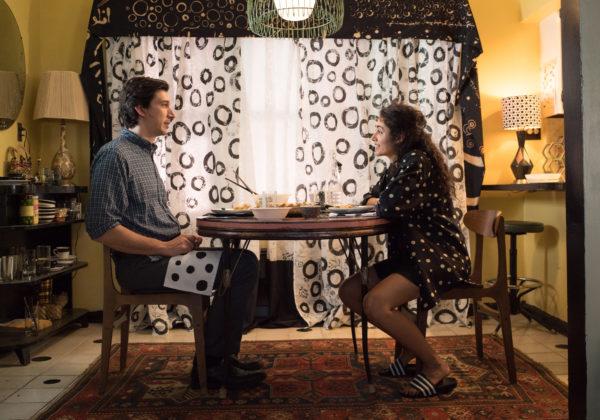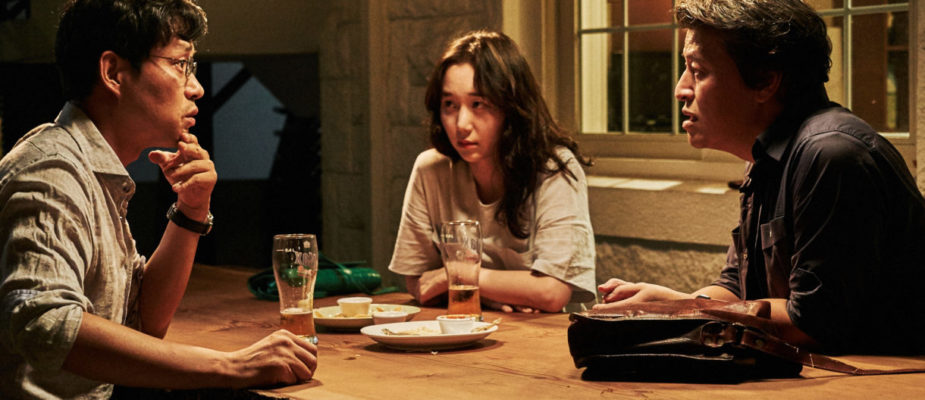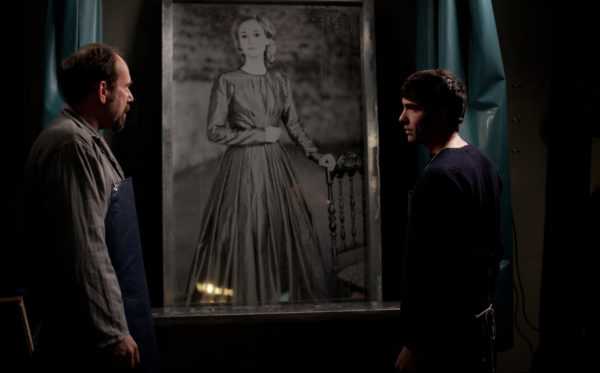One of the greatest pleasures of the major international film festival is the opportunity to see the latest work by leading international auteurs. In the case of South Korean director Hong Sang-soo, whose masterful previous feature Right Now, Wrong Then (2015) played at the Museum earlier this month, there has been at least one “latest” film every year since 2008, and eighteen feature films in all since he began directing in 1996. That’s an incredible number of films for any director, let alone an art-house filmmaker; and even more astonishing, given the extremely narrow set of alternatives that Hong has allowed his cinema, he is currently working better than he ever has.
Yourself and Yours (2016) is the latest–at least as of the September afternoon in which I am writing this–major accomplishment for a filmmaker whose Mondrianesque whites, blues, reds, yellows, and black lines are a filmmaker/artist, his pretty love interest or two, long conversations, and copious amounts of soju/beer. In Yourself and Yours, Hong introduces us, in the film’s first scene, to a painter, Young-soo (Kim Joo-hyuck), and a male friend who offers some gossip concerning Young-soo’s girlfriend, Minjung (Lee You-young): he has heard that she has been drinking and quarreling with other men in bars around town–this despite her promise to Young-soo to limit her drinking.
Hong shortly cuts to a coffee shop where we see a woman whom we assume to be Minjung. Another patron certainly believes too, having known her previously. He approaches, asking if she is indeed Minjung, and if she remembers him. Eventually she confesses to being not Minjung, but rather her identical twin sister. As Hong’s film progresses, Minjung, or someone just like her, will be confused with Minjung on more than occasion. In these subsequent encounters with men from her past, however, she does not identify herself as Minjung’s twin, nor does she admit to being Minjung–even when confronted by somebody who knows her very well.
Yourself and Yours pursues an idea related to something that Minjung’s identical twin (or whoever she is) says during her first coffee-shop conversation: namely, that she has discovered she is most men’s type. In Hong’s film, these many Minjungs–whether they’re all the same person or not–represent less the same character than a singular type; in a sense the male characters all see the same person, irrespective of whom the woman says she is. In this reading, Yourself and Yours becomes the latest in a series of self-reflexive reappraisals of the filmmaker’s art: though each of the women appear the same on the surface, beneath there exists differences. Of course, it is even more likely the case, given a final-act meeting between two of her suitors, that the female lead is only pretending not to be Minjung–a recursive scenario with more comedic than theoretical implications as she time and again allows herself to be picked up and juggle boyfriends. Then again, in the spirit of Right Now, Wrong Then, they both might be true, or neither; Hong proposes competing scenarios that turn on the truth/falsity of the female character(s)’ assertions. As an act of storytelling, it is possible for us to have both.
The accomplishment of Yourself and Yours is to make the old new, to find an original take on a very familiar type, something Hong manages to do with his one or multiple Minjungs. In contrast with the rigorous two-part structure of Right Now, Wrong Then or even the epistolary structure of his recent masterpiece Hill of Freedom (2014), the form of Yourself and Yours is looser and less strict and rigorous than we have become accustomed, in the last few years, with the Korean auteur. The director’s latest also possesses a greater depth of feeling than many of his better films even, achieving a moving payoff in the final meeting that is made possible by the film’s conceit; here, not to spoil Hong’s final twist, something old and familiar becomes magically new once again.
Japanese auteur Kiyoshi Kurosawa (no relation to Akira) is another director who has been very productive as of late, releasing five features and a five-episode television program all since 2012. Daguerrotype (2016), his first film shot outside of Japan in France, tells the fantastical story of a famed fashion photographer, Stéphane (Olivier Gourmet, The Son), who has taken to producing life-sized likenesses of his 22 year-old daughter using the archaic photo-chemical technology of the film’s English-language title. The film begins with Stéphane hiring a new assistant, Jean (Tahar Rahim), who is to help with his bizarre and unsettling process, one that involves locking his models in place with metal armature to insure that they remain motionless for his photography’s extremely exposure time. His pretty daughter Marie (Constance Rousseau) is the only model who seems to satisfy the obsessive widower, not only understanding but embracing the great burdens placed on the artist’s subjects.
As with the director’s fine Journey to Shore (2015), an allegory for life in post-Tsunami Japan, Daguerrotype is a work in which the dead walk among the living–Stéphane is haunted literally by his dead wife, and Jean by another character later on–and the living seek to capture some measure of immortality. It is also a film in which the director’s long-standing ecological concerns–see Charisma (1999) for an especially telling instance–which are traceable, in part, to the cultural influence of Shintoism, present themselves in the form of Marie’s interest in plants, and her work as a caretaker of the family’s greenhouse (which is threatened by the chemical waste from her father’s work). Kurosawa, in fact, fuses the two analogically in Marie, whose admiration for the plant-world reflects her awareness of their invisible movement and growth, something she can relate to in her marathon posing session. In France, Kurosawa finds a new way, in old technologies, of expressing his fundamentally Japanese subject.
The second highly accomplished film by the director to premiere this year–the first, the unmissable horror-thriller Creepy (2016), one of his deconstructions of Japanese masculinity and the family, will open at the Museum this November–Daguerrotype should be distinguished, most of all, for having one of the year’s greatest single shots. When father and daughter ascend the cellar staircase, leaving the space empty, Kurosawa slowly pushes in, holding on the empty architectural feature for an extended period of time, and beyond the point that it seems anything will happen. Something, of course does, and it has major ramifications for the remainder of this effective and deliberately told ghost story.
If any single shot bested Kurosawa’s this festival, it was the extremely long, surveillance-style, pre-credit take that opens Cristi Puiu’s extraordinary Sieranevada (2016). With Puiu’s camera panning back and forth as a couple, a child, and an older woman move in and out of graffiti-painted high-rise–and as the man is forced to move their car, circling the block over an extended duration, when he causes a traffic back-up. Throughout this extended, precisely choreographed passage that, in its exterior setting, will be more an exception to the film’s aesthetic than the rule, Puiu establishes the central importance of off-camera space to his art, a key conceit already in his previous The Death of Mr. Lazarescu (2005) and Aurora (2010).
After an extended comedic passage shot behind male lead Lary (Mimi Branescu) and his wife as they contend with the city’s excessive traffic, Sieranevada moves indoors for most of its remaining running time, setting up first in the center of a multi-room apartment, with each of the chambers opening onto the same interior hallway. In much the same way as in the opening sequence-shot, Puiu’s camera pans from the threshold of one room to another as the film’s many characters dart in and out of the spaces, disappearing into the visually occluded chambers–in the manner of Aurora–or closing the door on the filmmaker entirely (thus again reinforced the extreme self-imposed limitations of the director’s visual field). Slowly, Puiu maps the worn and somewhat shabby apartment, with scene after scene, incident after incident unfolding in spare natural light in one room following another. This is one of those truly remarkable examples of a visual approach that is totally singular to its maker and still expressive of a way of life, of the often reduced circumstances of life in contemporary Romania (even among its middle-class).
On the level of narrative structure, as opposed to visual style, it is the director’s earlier masterpiece, The Death of Mr. Lazarescu, to which his latest is most closely associated. In Sieranevada, we have an extended family present for a funeral dinner, a meal which first must wait for the arrival of an Orthodox priest, and later for any series of interpersonal issues to be resolved. Nearly three hours in its length, Sieranevada, like The Death of Mr. Lazarescu before it, concerns itself with the interminable duration that occurs before the act. The characters frustrated experience becomes that of the viewer as the film moves glacially towards their meal.
Yet, Sieranevada is by no means an alienating or dull experience–or at least it certainly wasn’t for this viewer who is more eager to see this film again than any other film at TIFF. For starters, Puiu brings a large extended family to life, slowly disclosing their various interpersonal dynamics as the film’s lengthy running time progresses. Indeed, this is a film where we as viewers attend more to character relations and personality than to its basic plot. Then there are the predominate subjects of the many exchanges and arguments, which likewise lends interest to this talking picture: religion, politics (with one 9/11 “truther” even citing Oklahoma City as an example of a theory his cousins are quick to discredit), and sex. Sieranevada subtly charts differences in these areas along family and generational lines, creating an experience that really does feel like spending time with extended family.
For all the film’s life and for the complete singularity of its formal approach–Puiu again has created a new film language derivative of Romanian tower-block architecture–Sieranevada is masterpiece, and perhaps the best film to screen at TIFF this year.

Concluding my week at this year’s Toronto International Film Festival was Jim Jarmusch’s outstanding Paterson (2016), easily the best of the American movies I screened at the festival. Adam Driver (Star Wars: The Force Awakens) stars as Paterson–that’s his real name–a bus driver and amateur poet who lives with his very charming, if scattered wife Laura (Golshifteh Farahani) in Paterson, New Jersey. Jarmusch’s film develops over the course of a single week with the title hero and city namesake waking up beside his sleeping wife around the same time each morning, checking his watch–Jarmusch attends closely to objects throughout–and then eating cheerios from a cup, before commuting by foot across the city’s rundown, post-industrial landscape. In the evenings, after a sometimes questionable dinner prepared by his enthusiastic young wife, Paterson walks his English Bulldog to a local African-American pub where he discusses the city’s peculiar history with the local barkeeper. Paterson is a film of quotidian incidence and routine, as well as a work of rust belt decay and allegiance–Jarmusch is an Ohio native–in the manner of his previous feature Only Lovers Left Alive (2013).
On the bus, Paterson eavesdrops on his more amusing passengers, in this way acting as a surrogate for the audience as Jarmusch includes their light exchanges. In his downtime, especially in those moments that he eats from his lunchbox while seated before the city’s picturesque waterfall, the working-class Paterson crafts poetic verse, scribbling it in his special notebook and voicing it on screen in a slow staccato (that also seems to remind one of the director’s own halting baritone). He is one of many creatives in Paterson, with Laura, for instance, dreaming of both a cupcake business and becoming a country superstar, while redecorating their entire home according to her preferred black-and-white aesthetic–totally remaking the world, according to her point-of-view, in the manner of the director; a rapper who works on his rhymes in a hole-in-the-wall laundry; and a ten year-old, seated alone outside one of the old factories, writing poetry that especially moves Paterson. (She is also one of a set of identical twins in Paterson, a motif that also correlates to the hero and the city with which he shares a name.)
Jarmusch and Driver, who is quite effective in the film’s lead role, manage a real emotional intensity as the film’s hero experiences personal loss at the end of a week that has slowly begun to unravel. A moment of private crisis–not unlike that of the city’s for which the lead further stands in, and with the director expresses his solidarity–Paterson chooses finally to persevere, continuing to create even after his art has been taken away. Paterson is one of Jarmusch’s more moving films to date.
To complete my time at the 2016 Toronto International Film Festival, among my more satisfying festival experiences, let me list my favorites, drawn from those films that I saw at the event. This will exclude the Berlin premieres I saw in February (like the sublime A Quiet Passion and the excellent Things to Come), and also those films that will be programmed at the Museum between now and the end of November. Here are my TIFF ten best:
- Sieranevada (Cristi Puiu, Romania)
- Nocturama (Bertrand Bonello, France)
- Toni Erdmann (Maren Ade, Germany)
- Paterson (Jim Jarmusch, United States)
- Yourself and Yours (Hong Sang-soo, South Korea)
- The Ornithologist (João Pedro Rodrigues, Portugal)
- Elle (Paul Verhoeven, France)
- Hermia & Helena (Matías Piñeiro, Argentina/United States; pictured above)
- Daguerrotype (Kiyoshi Kurosawa, France/Japan)
- The Woman Who Left (Lav Diaz, Philippines)













